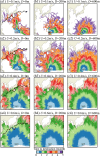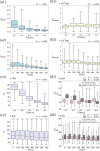The calculated voyage: benchmarking optimal strategies and consumptions in the Japanese eel's spawning migration
- PMID: 39482316
- PMCID: PMC11528122
- DOI: 10.1038/s41598-024-74979-0
The calculated voyage: benchmarking optimal strategies and consumptions in the Japanese eel's spawning migration
Abstract
Eels migrate along largely unknown routes to their spawning ground. By coupling Zermelo's navigation solution and data from the Japan Coastal Ocean Predictability Experiment 2 (JCOPE2M), we simulated a range of seasonal scenarios, swimming speeds, and swimming depths to predict paths that minimize migration duration and energy cost. Our simulations predict a trade-off between migration duration and energy cost. Given that eels do not refuel during their migration, our simulations suggest eels should travel at speeds of 0.4-0.6 body-length per second to retain enough energy reserves for reproduction. For real eels without full information of the ocean currents, they cannot optimize their migration in strong surface currents, thus when swimming at slow swimming speeds, they should swim at depths of 200 m or greater. Eels swimming near the surface are also influenced by seasonal factors, however, migrating at greater depths mitigates these effects. While greater depths present more favorable flow conditions, water temperature may become increasingly unfavorable, dropping near or below 5 °C. Our results serve as a benchmark, demonstrating the complex interplay between swimming speed, depth, seasonal factors, migration time, and energy consumption, to comprehend the migratory behaviors of Japanese eels and other migratory fish.
Keywords: Eel; Energy consumption; Migration; Ocean current; Optimization; Swimming speed and depth.
© 2024. The Author(s).
Conflict of interest statement
The authors declare no competing interests.
Figures






Similar articles
-
Swimming physiology of European silver eels (Anguilla anguilla L.): energetic costs and effects on sexual maturation and reproduction.Fish Physiol Biochem. 2010 Sep;36(3):297-322. doi: 10.1007/s10695-010-9397-4. Fish Physiol Biochem. 2010. PMID: 20390348 Free PMC article.
-
Eel migration to the Sargasso: remarkably high swimming efficiency and low energy costs.J Exp Biol. 2005 Apr;208(Pt 7):1329-35. doi: 10.1242/jeb.01524. J Exp Biol. 2005. PMID: 15781893
-
Active swimming and transphort by currents observed in Japanese eels (Anguilla japonica) acoustically tracked in the western North Pacific.Sci Rep. 2022 Mar 1;12(1):3490. doi: 10.1038/s41598-022-05880-x. Sci Rep. 2022. PMID: 35232985 Free PMC article.
-
A century of research on the larval distributions of the Atlantic eels: a re-examination of the data.Biol Rev Camb Philos Soc. 2015 Nov;90(4):1035-64. doi: 10.1111/brv.12144. Epub 2014 Oct 8. Biol Rev Camb Philos Soc. 2015. PMID: 25291986 Review.
-
Migratory life cycle of Anguilla anguilla: a mirror symmetry with A. japonica.J Fish Biol. 2025 Feb;106(2):138-156. doi: 10.1111/jfb.15966. Epub 2024 Oct 23. J Fish Biol. 2025. PMID: 39439402 Review.
References
-
- Alerstam, T., Hedenström, A. & Åkesson, S. Long-distance migration: Evolution and determinants. Oikos 103, 247–260 (2003).
-
- Dingle, H. & Alistair Drake, V. What is migration?. Bioscience 57, 113–121 (2007).
-
- Luschi, P., Hays, G. C. & Papi, F. A review of long-distance movements by marine turtles, and the possible role of ocean currents. Oikos 103, 293–302 (2003).
-
- Alerstam, T. Conflicting evidence about long-distance animal navigation. Science 313, 791–794. 10.1126/science.1129048 (2006). - PubMed
MeSH terms
Grants and funding
LinkOut - more resources
Full Text Sources

